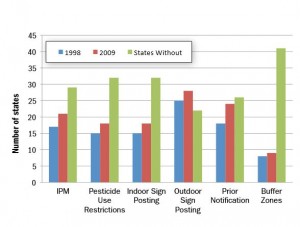
The most recent issue of American Entomologist (Volume 60, Number 2) contains an interesting article authored by 11 top professionals concerned with the safety of pest management practices. One of the authors is our own Lynn Braband who leads the NYS Integrated Pest Management Program’s SCHOOL IPM group.
The article, Regulating Pesticide Use in United States Schools, is worth a read for its non-political, practical insight into what is going on nationally in schools.
The first law to regulate pesticide use in schools was passed in 1991 in Texas. Since that time, 39 states have enacted legislation and policies to regulate the use of pesticides including changes to how pesticides are applied, record-keeping, pesticide-free zones, pre-notification and posting when pesticides are applied, limitations on active ingredients that can be utilized, and enforcement or penalties for violations.

Numbers of states with legislation in key components of pesticide-use safety in 1998 and 2008, as well as the number of states without such legislated compliance.
Why is this important? School pests are not only annoying but they can also affect children’s health. The number one cause of student medical absences in schools is asthma brought on by allergic reactions to exposure to cockroaches, rodents and dust mites. Simply increasing pesticide use is not the answer, because exposure to pesticides is also linked to increased incidence of asthma.
As a parent, pesticide applicator, school safety officer, teacher or staff, or concerned citizen, it is wise to understand the larger picture of pesticide use in schools across the nation as we all work to improve pest management in your school district.
Through interviews with state officials, the article’s authors assessed the effectiveness of regulations, compared them, and inquired after officials’ wish-lists as to how to improve them.
There is no federal law addressing pesticides or Integrated Pest Management in schools, so state provisions vary widely. For example, eleven states restrict or require notification of pesticide applications to reduce drift. Nine states have buffer zones, but they vary from 300 feet to two-and-a-half miles. Quite a difference. Does your state have these restrictions? You should know, or find out.
The New York State Neighbor Notification Law (2000) applies to all public and non-public K-12 schools (not universities) and requires all parents and staff to be notified in writing at the start of each school year that pesticides may be used periodically, and that the school is required to notify them 48 hrs in advance IF REQUESTED. Those who request notification are placed on a registry and, unless there is an emergency application, receive notification. In the future we will devote a blog post to the concept of ’emergency applications’, just one small part of the larger discussion. Another post will address the incidental changes in attitudes this law created.
http://ae.oxfordjournals.org/content/60/2/105 is a link to the Journal and gives you the option to download the full article as pdf.
A lot of work went into this article and should serve as a basis to improve pesticide safety on school grounds. We appreciate their efforts and this important article.






